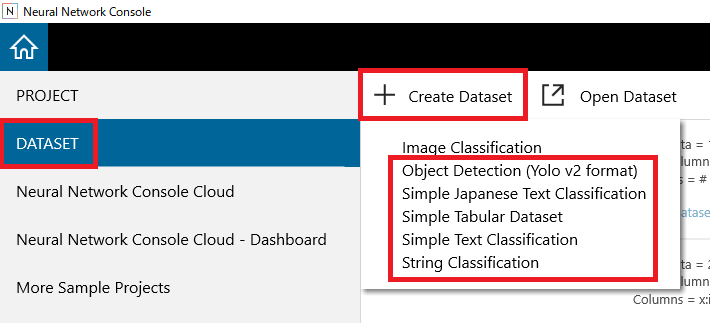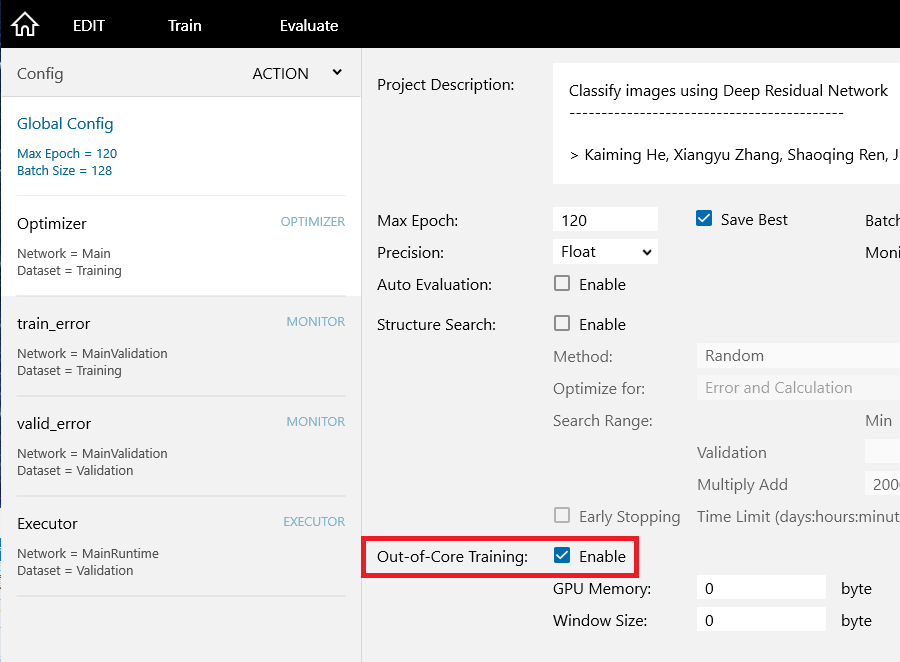We have updated the Neural Network Console Windows today.
This post will introduce the major updates.
・Addition of various pre-processing plugins to facilitate dataset creation
・Addition of export function in TensorFlow 2.0 saved_model format and tflite format (beta)
・Reduce GPU memory required for training and addition of Out-of-Core function to train a large model that exceeds the size of GPU memory
・Addition of SHAP, SHAP(batch) and TracIn plugins
・Others
1. Addition of various pre-processing plugins
Various new pre-processing plugins make it easier to create dataset CSV file handled by Neural Network Console.
Pre-processing plugins can be used from the Create Dataset button in the DATASET of the screen after startup.

The newly added pre-processing plugins are as follows
| Object Detection (Yolo v2 format) | A utility for creating a dataset CSV file for object detection that detects the category and position of the image contained in the input image. Converts the Yolo v2 format for object detection, which describes the category and coordinates of the object in the text file prepared for each image file, to the Neural Network Console dataset CSV file format. |
| Simple Text Classification | Supports the creation of a dataset CSV file for sentence classification that classifies input English sentences into categories. Converts the sentences contained in the input CSV file to the word index series and the length of the word index series. |
| Simple Japanese Text Classification | Japanese version of Simple Text Classification. Supports the creation of a dataset CSV file for sentence classification that classifies input Japanese sentences into categories. |
| String Classification | Charactor version of Simple Text Classification. It treats sentences as a series of characters rather than word sequences, so it can be used for classification tasks in any language. Converts the sentence contained in the input CSV file to the character index series and the length of the character Index series. |
| Simple Tabular Dataset | Converts the input structured data CSV file to Neural Network Console’s dataset CSV file format. By converting the categorical variables of the explanatory variables included in the input CSV file into one-hot vectors and standardizing the continuous variables, they are converted into a single multidimensional vector that is easy to handle in neural networks. |
More detailed usage of each plugin will be explained in future videos and blog articles.
2. Addition of export function in TensorFlow 2.0 saved_model format and tflite format (beta)
The model trained using Neural Network Console can now be exported in saved_model format of TensorFlow 2.0 or tflite format.
To export the model, right-click the training result containing the model and select “saved_model (TensorFlow)” or “tflite (TensorFlow lite) from the shortcut menu.

With this export functionality, models trained with Neural Network Console can now be executed in a wider range of environments.
3. Reduce GPU memory required for training and addition of Out-of-Core function to
train a large model that exceeds the size of GPU memory
In recent years, deep learning model size has been increasing rapidly, but there have been GPU memory restrictions on the size of the model that can be trained.
This time, the improved utilization efficiency reduces the GPU memory required to train model of the same size.
This makes it possible to train model with larger size or larger batch-size simply by using the latest version.
Furthermore, by using the newly added Out-of-Core training function, data that does not fit in the GPU memory can be temporarily cached in the CPU memory, enabling training of model that exceeds the GPU memory limit. Check Enable on Out-of-Core training in Global Config on CONFIG tab.

4. Addition of SHAP, SHAP(batch) and TracIn plugins
Three new XAI-related post-proceessing plugins have been added to help interpret trained model.
| SHAP | Using a method called SHAP [1], the areas of the input image that affect the classification result are made visible in the model. |
| SHAP(batch) | SHAP Process is performed for multiple images |
| TracIn | Using a method called TracIn [2], the influence of the input images on recognition result are evaluated. |
5. Others
Addition of function to resume suspended training
You can now resume interrupted training by right click the training result list to open a shortcut menu, and click Resume Training.

Supports multiple inputs for Unit
Now the Unit layer can handle multiple input by defining multiple inputs in the network used as Unit and and specifying the order of the inputs in the Unit by using Order property,
The first input can be connected to the input of the Unit layer and the second and subsequent input can be connected to the side connector of the Unit layer.

Additon of the layers.
InstanceNormalization, GroupNormalization, LayerNormalization, Norm, NornNormalization, WeightStandardization layers have been added.
Addition of optimizer
AdaBelief optimizer has been added.
Addition of sample projects
The newly added sample projects are as follows
| Adult | Classification using Adult dataset [3] |
| wav_keyboard_sound | 4 class wav file classification using Keyboard sound dataset dataset [4] |
| binary_semantic_segmentation | Binary semantic segmentation using Character extraction dataset [5] |
| 20newsgroups_classification | 20 class sentence classification using 20NewsGroups dataset [6] |
| 20newsgroups_word_embedding | Word embedding (word2vec) using 20NewsGroups dataset [6] |
| 20newsgroups_lstm_language_model | LSTM language model using 20NewsGroups dataset [6] |
| 20newsgroups_transformer_language_model | Transformer language model using 20NewsGroups dataset [6] |
For details on each newly added function, please also refer to the included manual.
We will continue to update Neural Network Console.
We look forward to getting feedbacks from the users for futher improvements!
Neural Network Console Windows
https://dl.sony.com/ja/app/
[1] SHAP
A Unified Approach to Interpreting Model Predictions
Scott Lundberg, Su-In Lee
https://arxiv.org/abs/1705.07874
[2] TracIn
Estimating Training Data Influence by Tracing Gradient Descent
Garima Pruthi, Frederick Liu, Mukund Sundararajan, Satyen Kale
https://arxiv.org/abs/2002.08484
[3] Adult Data Set
https://archive.ics.uci.edu/ml/datasets/adult
[4] Keyboard sound dataset
https://support.dl.sony.com/blogs-ja/dataset/keyboard-sound-dataset/
[5] Character extraction dataset
https://support.dl.sony.com/blogs-ja/dataset/character-extraction-dataset/
[6] 20Newsgroups
http://qwone.com/~jason/20Newsgroups/
